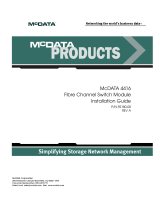
FA Q s
SANbox
®
9000 Series
Stackable Chassis Switch
48. Question: Is the SANbox 9000 Series available in a Front-to-Back airflow version?
Answer: As of February, 2007, both SANbox 9000 models can be ordered in an “A” Front-to-Back Airflow version (new SKU #s SB9100-16A-E and SB9200-
32A-E). Corresponding Front-to-Back Power Supply Blade and Fan Blade Spares are also available (new SKU #s SB9000-APS and SB9000-AFAN). Note: As
an alternative, both “A” and “B” airflow model chassis modules can be reversed racked with existing adjustable rail kits.
49. Question:
Will an upgrade kit be available to change a currently installed SANbox 9100 or 9200 model from “B” Back-to-Front airflow to “A” Front-to-Back
airflow?
Answer:
No upgrade kits are currently planned. However, the upgrade can be accomplished by the customer buying replacement spare “A” Power Supply
Blades and “A” Fan Blades Spares. Note: all installed Power Supply and Fan Blades in a chassis module must be the same direction or the switch will boot
up in a faulted (but operable) state with a FAN_FLOW_MISMATCH warning message. The fault condition cannot be cleared by the Administrator other than by
physically replacing the FAN/PS BLADES so that they all have the same airflow direction.
50. Question:
Has the SANbox 9000 Series Configurator Sales Tool be updated to include these new “-E” SKUs?
Answer:
Yes, the SANbox 9000 Configurator Sales Tool has been updated for the new “-E” SKUs. In addition, the 10Gb ISL cables/transceivers, Spare CRUs/
FRUs, software maintenance renewal SKUs, and FT/HyperStack features have been included. Note: the Configurator Sales Tools are available on the QLogic
internal ViSION portal and the QLogic external Partner Connection web sites.
51. Question: Can the SANbox 9000 Series switches interoperate in a heterogeneous fabric with non-QLogic switches?
Answer: Yes, the SANbox 9000 Series switches can interoperate with Brocade
®
, McDATA
®
, and Cisco switches in the same fabric, as long as the non-QLogic
switches are operating in “Open Mode”. Specifically, QLogic does not support interoperability with these switches in their respective “Native Modes”.
52. Question: Since the Serial port on the CPU Blade has an RJ-45 connector, how can I attach to a cable with a DB-9 connector?
Answer: An RJ-45 to DB-9 conversion dongle is included as a standard accessory with each chassis module.
53. Question:
Since the Blades are CRUs, is there a maintenance option to stock replaceable parts on [a customer’s] site?
Answer:
Global Services does not presently have a specific Service Plan that provides such an option. However, CRU spare part SKUs are available in the
QLogic Order Entry System; the customers can buy these themselves.
54. Question: Is it possible for a QLogic channel partner to provide SANbox 9000 maintenance?
Answer: QLogic Global Services currently offers our QSPP program, which allows Signature and Signature Preferred partners to provide part of the service
delivery. In return, they buy different SKUs off a discounted price list. If the partner has the appropriate training, they can be authorized on this SANbox 9000
platform. Please contact your QLogic Global Services representative for more information.
55. Question:
Is the SANbox 9000 Series on EMC
®
’s E-Lab™ ESM qualification listing?
Answer: Yes, both the SB9100 ENTRY model and the SB9200 BASE model are on the EMC
®
E-Lab ESM Listing as of January, 2007. These models can be
ordered on the QLogic Order Entry system as SKU #s SB9100-16A-E and SB9200-32A-E. These new “-E” SKUs are Front-to-Back airflow models and do NOT
have 4Gb SFPs included. Finally, existing installed SB9000 models can be non-disruptively upgraded via NDCLA to this EMC qualification level by installing
the latest firmware version (6.2.1.06) and the new EFS2007 software version (6.03.06), both available via download from the QLogic web site. See February’s
QLogic NSG Marketing Bulletin for more information. Note: FT/HyperStack firmware version 6.6 and EFS2007 software version 6.07 are currently being quali-
fied in the EMC E-Lab.
56. Question: How much additional power does a dual SANbox 9200 HyperStack use versus two individual SANbox 9200s?
Answer: An additional 20 watts with no data traffic; 40 watts with full data trafic.
57. Question: What is the warranty period on the HyperStack cables?
Answer: Since the HyperStack cables are classified as an accessory, the warranty period is 90 days.









